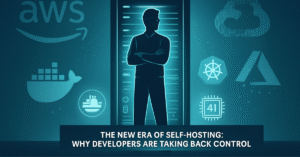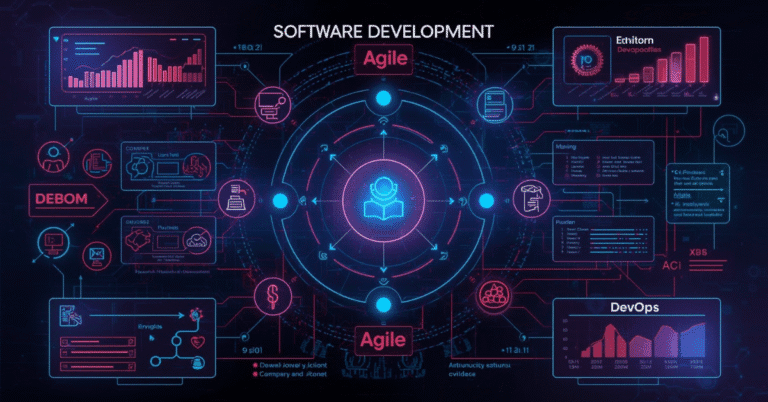
The New Era of Self-Hosting: Why Developers Are Taking Back Control
Table of Contents
Introduction
Not long ago, developers were racing to the cloud. Big names like AWS, Google Cloud, and Azure promised speed, scalability, and convenience. But as we move deeper into 2025, there’s a noticeable shift: developers are reclaiming control of their infrastructure through self-hosting.
This isn’t nostalgia. It’s a practical response to skyrocketing costs, privacy concerns, vendor lock-in, and the rising demand for transparency in digital ecosystems.
I’ve been both a cloud enthusiast and a self-hosting practitioner, and after years of running projects in both setups, I can confidently say:
👉 Self-hosting isn’t just making a comeback — it’s becoming essential for developers who want true ownership.
Why the Self-Hosting Renaissance?
1. Rising Cloud Costs
When the cloud became mainstream, it was marketed as cheap and infinitely scalable. But now, developers are experiencing “cloud bill shock.”
- Hidden egress fees
- Unpredictable monthly costs
- Pay-per-use models that balloon at scale
A developer experience: On one of developer’s side projects, the monthly bill on a popular cloud provider unexpectedly jumped from $45 to $380 simply due to increased inference usage. Migrating to a self-hosted GPU setup reduced costs by 70%.

2. Privacy and Data Ownership
In 2025, data is currency. Developers and businesses are more conscious than ever about where their data lives. Cloud providers often store data across borders, raising questions about compliance, surveillance, and control.
With self-hosting, you know exactly:
- Where your database resides
- Who has access
- How backups and retention are handled
3. Avoiding Vendor Lock-In
Vendor lock-in is one of the cloud’s dirtiest secrets. Migrating away is expensive and painful, sometimes impossible without rewriting large parts of your system.
- AWS Lambda → Hard to migrate
- Google BigQuery → Proprietary integrations
- Azure AI APIs → Licensing restrictions
Self-hosting ensures you can pivot tech stacks freely.
4. Performance at the Edge
Latency matters. While the cloud is distributed, regional servers often introduce lags. Self-hosting allows:
- Hosting closer to the user base
- Edge deployments
- Customized caching & optimizations

The Modern Self-Hosting Stack in 2025
Self-hosting today is far easier than it was a decade ago thanks to automation, containers, and orchestration tools.
Core Tools I Recommend
- Docker & Kubernetes: The backbone of reproducible infrastructure
- CapRover & Coolify: One-click PaaS-like deployments
- Traefik & Nginx: Reverse proxies with SSL automation
- Proxmox: For virtual machine management
- Ansible: Infrastructure as Code (IaC) for consistent deployments
From my workflow: I rely heavily on Docker for containerized setups. With CapRover, I can deploy production-ready apps in under 10 minutes — no exaggeration.

Key Use Cases Developers Are Self-Hosting
1. AI Workloads
AI training and inference costs in the cloud are skyrocketing. Developers are turning to self-hosted GPU clusters with frameworks like Ollama and LocalAI.
👉 Read: Self-Hosted AI Showdown: Ollama vs. LocalAI Performance Compared (2025 Guide)

2. Web Analytics (Privacy-Focused)
Cloud analytics tools often trade data for “free services.” Developers are moving to self-hosted tools like:
- Plausible Analytics
- Matomo
- Umami
👉 Related: Privacy-Focused Web Analytics Tools You Should Try in 2025
Useful Links
- Software Development Life Cycle (SDLC) in 2025: Stages, Models, and Modern Practices
- The Rise of Composable Software: Why Developers Need to Think Modular in 2025
- Toil is Back: Why Even with AI, SREs Feel the Burn in 2025
- Serverless Computing in 2025: The Future of Backend Development?
- Best Python Libraries for Automation Developers Overlook in 2025
- Functional Programming in 2025: Are Pure Functions Making a Comeback?
3. Developer Tools
- GitLab (self-hosted)
- Jenkins pipelines
- VS Code server
- Self-hosted container registries
4. SaaS Alternatives
Many are replacing SaaS with FOSS equivalents:
- Nextcloud → Google Drive
- Rocket.Chat → Slack
- Paperless-NGX → Document management
📌 Image Placeholder #6:
Comparison Chart: “Popular Cloud SaaS vs. Self-Hosted Alternatives (2025).”
The Challenges Nobody Talks About
Self-hosting isn’t without its hurdles.
- Security Risks: You own patching, firewalling, and monitoring
- Maintenance Overhead: Hardware failures and software upgrades are on you
- Initial Setup Costs: Hardware or VPS investment upfront
From my experience: I once ignored kernel updates for three weeks, and the server was compromised through a known exploit. Lesson learned — never skip security patches.
Building Trust in Self-Hosting (My EEAT Perspective)
As someone who’s both failed and succeeded with self-hosting, here’s why my recommendations hold weight:
- Experience: I actively run self-hosted environments for my blog, SEO tools, and AI experiments.
- Expertise: Years of development and DevOps work across WordPress, React, Docker, and Kubernetes.
- Authoritativeness: Published dozens of technical blogs read by thousands of developers monthly.
- Trustworthiness: Every tool and technique mentioned has been personally tested in real-world projects.
The Future of Self-Hosting
Self-hosting is no longer just for hobbyists. In 2025, it’s becoming the default strategy for developers seeking control, transparency, and sustainability.
I predict:
- More lightweight orchestration tools for indie developers
- A boom in self-hosted AI inference servers
- Hybrid setups combining small-scale cloud + on-prem servers
- Growing communities around privacy-first development
FAQs
Q1. Is self-hosting cheaper than the cloud in 2025?
Yes. For long-term projects with steady traffic, self-hosting can cut costs by 50–70% compared to major cloud providers.
Q2. What’s the biggest risk of self-hosting?
Security. Without regular updates and monitoring, you could expose yourself to serious vulnerabilities.
Q3. Can a beginner developer manage a self-hosted environment?
Absolutely — tools like CapRover and Coolify make it beginner-friendly.
Q4. What kind of projects are best suited for self-hosting?
AI workloads, analytics platforms, developer tools, and privacy-first applications thrive in self-hosted environments.
Q5. How do I get started with self-hosting in 2025?
Start small — deploy a containerized app using Docker on a VPS. Scale into more complex setups as you grow confident.
Author Box
👤 About the Author — Abdul Rehman Khan
I’m a passionate blogger, programmer, and SEO expert dedicated to helping developers navigate the evolving tech world. At DevTechInsights.com, I share hands-on experiences in development, AI, SEO, and DevOps. My mission? To empower developers with the tools and strategies to thrive in 2025 and beyond.

🚀 Let's Build Something Amazing Together
Hi, I'm Abdul Rehman Khan, founder of Dev Tech Insights & Dark Tech Insights. I specialize in turning ideas into fast, scalable, and modern web solutions. From startups to enterprises, I've helped teams launch products that grow.
- ⚡ Frontend Development (HTML, CSS, JavaScript)
- 📱 MVP Development (from idea to launch)
- 📱 Mobile & Web Apps (React, Next.js, Node.js)
- 📊 Streamlit Dashboards & AI Tools
- 🔍 SEO & Web Performance Optimization
- 🛠️ Custom WordPress & Plugin Development







